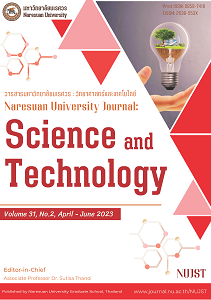Forecasting Short-Term Crude Oil Prices with a Deep Learning Approach
DOI:
https://doi.org/10.14456/nujst.2023.18Keywords:
Crude oil price, Sentiment data, Neural network, Short-term forecasting, Deep Feed ForwardAbstract
This paper presents a multi-layer neural network model to forecast short-term crude oil prices. The model is designed and developed for learning and analyzing the volatility of oil prices based on demand and supply fundamentals and sentiment data from online news. Potential keywords from the news regarding oil prices and price movements were grouped, pre-processed, and used as the neural network’s input features. The stochastic gradient descent and regularization techniques were applied for neural learning. Designing the neural network for our study includes three models: The Fundamentals Model (FDM), Single Word Model (SWM), and Combined Word Model (CWM). Experimental results achieved show that the proposed model is promising for crude oil price forecasting for the next 1, 2, 3, and 5 days with mean absolute percentage errors of less than 3% for all test cases. There were also unnoticeable forecasting errors using demand-supply fundamentals alone and with sentiment data. However, our experiments have shown that the CWM had a higher Goodness-of-Fit to the model, and R-squared value, indicating greater predictability than the FDM and SWM models.
References
Alameer, Z., Elaziz, M. A., Ewees, A. A., Ye, H., & Jianhua, Z. (2019). Forecasting gold price fluctuations using improved multilayer perceptron neural network and whale optimization algorithm. Resources Policy, 61, 250 – 260.
Anggraeni, W., Mahananto, F., Sari, A. Q., & Zaini, Z. (2019). Forecasting the price of Indonesia's rice using hybrid artificial neural network and autoregressive integrated moving average (Hybrid NNs-ARIMAX) with exogenous variables. Procedia Computer Science, 161, 677 – 686.
Apichottanakul, A., Piewthongngam, K., & Pathumnakul, S. (2009). Using an artificial neural network to forecast the market share of Thai rice. Proceeding of IEEE International Conference on Industrial Engineering and Engineering Management 8-11 December 2009 (pp. 665-668). Hong Kong: China. https://www.doi.org/10.1109/IEEM.2009.5373247
Assaad, R. & Fayek, S. (2021). Predicting the Price of Crude Oil and its Fluctuations Using Computational Econometrics: Deep Learning, LSTM, and Convolutional Neural Networks. Econometric Research in Finance, 6(2), 119-137. https://doi.org/10.2478/erfin-2021-0006
Bai, Y., Li, X., Yu, H., & Jia, S. (2022). Crude oil price forecasting incorporating news text. International Journal of Forecasting, 38(1), 367 – 383.
Busari, G. A., & Lim, D. H. (2021). Crude oil price prediction: A comparison between AdaBoost-LSTM and AdaBoost-GRU for improving forecasting performance. Computers & Chemical Engineering, 155, 107513.
Co, H. C., & Boosarawongse, R. (2007). Forecasting Thailand's rice export: Statistical techniques vs. Artificial neural networks. Computers & Industrial Engineering, 53(4), 610 – 627.
Dikaiakos, M. D., Stassopoulou, A., & Papageorgiou, L. (2005). An investigation of web crawler behavior: characterization and metrics. Computer Communications, 28(8), 880 – 897.
Fernandes, L., Barbosa-Póvoa, A. P., & Relvas, S. (2010). Quantitative Financial Risk Management. In D.Wu (Ed.), Berlin: Springer.
Huang, L., & Wang, J. (2018). Global crude oil price prediction and synchronization based accuracy evaluation using random wavelet neural network. Energy, 151, 875 – 888.
Hui, C. H., Lo, C. F., Cheung, C. H., & Wong, A. (2020). Crude oil price dynamics with crash risk under fundamental shocks. The North American Journal of Economics and Finance, 54, 101238.
Hu, Y., Ni, J., & Wen, L. (2020). A hybrid deep learning approach by integrating LSTM-ANN networks with GARCH model for copper price volatility prediction. Physica A: Statistical Mechanics and its Applications, 557, 124907.
Kamyk, J., Kot-Niewiadomska, A., & Galos, K. (2021). The criticality of crude oil for energy security: A case of Poland. Energy, 220, 119707.
Kingma, D. P., & Ba, J. (2015). Adam: A method for stochastic optimization. In Proceedings of the 3rd International Conference on Learning Representation, 7-9 May 2015 (pp. 1-15). San Diego: California.
Li, Y., Jiang, S. Li, X., & Wang, S. (2021). The role of news sentiment in oil futures returns and volatility forecasting: Data-decomposition based deep learning approach. Energy Economics, 95, 105140.
Niu, Z., Liu, Y., Gao, W., & Zhang, H. (2021). The role of coronavirus news in the volatility forecasting of crude oil futures markets: Evidence from China. Resources Policy, 73, 102173.
Sadik, Z., Date, P., & Mitra, G. (2019). Forecasting crude oil futures prices using global macroeconomic news sentiment. Journal of Management Mathematics, 2019, 1 – 25.
Sahebi, H., Nickel, S., & Ashayeri, J. (2014). Strategic and tactical mathematical programming models within the crude oil supply chain context – a review. Computers & Chemical Engineering, 68, 56 – 77.
Stevanovic, D., An, A., & Vlajic, N. (2012). Feature evaluation for web crawler detection with data mining techniques. Expert Systems with Applications, 39(10), 8707 – 8717.
Tsiligiannis, A., & Tsiligiannis, C. (2020). Oil refinery sludge and renewable fuel blends as energy sources for the cement industry. Renewable Energy, 157, 55 – 70.
Wang, M., Zhao, L., Du, R., Wang, C., Chen, L., Tian, L., & Stanley, H. E. (2018). A novel hybrid method of forecasting crude oil prices using complex network science and artificial intelligence algorithms. Applied Energy, 220, 480 – 495.
Zhao, C., & Chen, B. (2014). China’s oil security from the supply chain perspective: A review. Applied Energy, 136, 269 – 279.
Zhang, K., & Hong, M. (2022). Forecasting crude oil price using LSTM neural networks. Data Science in Finance and Economics, 2(3), 163-180.
Zhang, Z., He, M., Zhang, Y., & Wang, Y. (2022). Geopolitical risk trends and crude oil price predictability. Energy, 258, 124824.
Downloads
Published
How to Cite
Issue
Section
License
Copyright (c) 2023 Naresuan University Journal: Science and Technology (NUJST)

This work is licensed under a Creative Commons Attribution-NonCommercial 4.0 International License.














